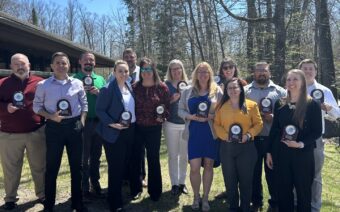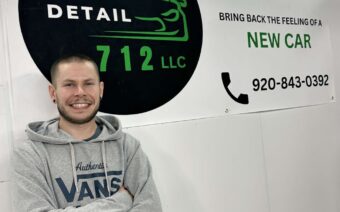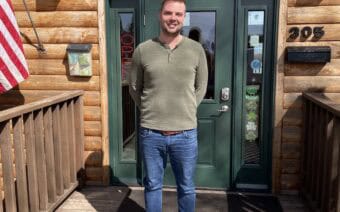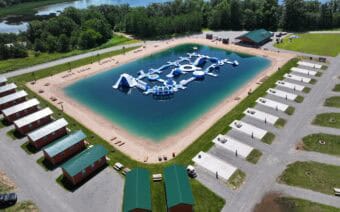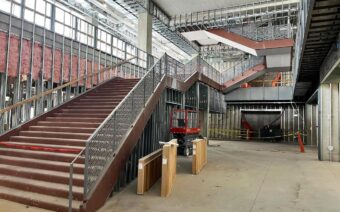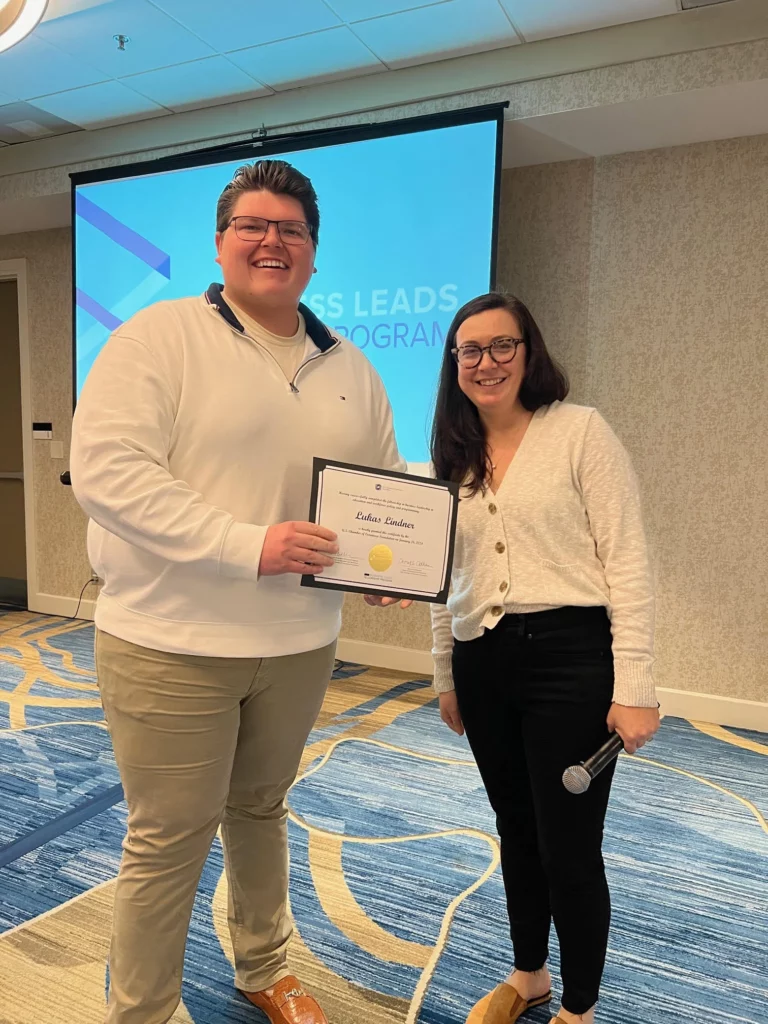
March 4, 2024
WAUSAU – Lukas Lindner – the workforce development and advocacy director for the Greater Wausau Chamber of Commerce – recently graduated from the U.S. Chamber of Commerce Foundation’s eighth cohort of its premiere business leadership program.
He is just the third chamber leader from Wisconsin to be selected for and graduate from the program.
The focus of the program, according to the U.S Chamber, is to train and equip leaders from state and local chambers of commerce, economic development agencies and trade associations with resources, access to experts and a network of peers to build their capacity to address the most pressing education and workforce challenges.
Lindner said his participation in the six-month program provided him with confirmation that what the Greater Wausau Chamber of Commerce is doing in terms of workforce development and advocacy is on target.
He said he was also able to learn more about other chambers’ best practices and real-life know-how, some he could apply close to home.
The lifelong Wausau area resident was selected as one of 35 state and local chamber executives, economic development professionals and association leaders to participate in the program.
Educational background
After graduating from D.C. Everest Senior High School, Lindner furthered his education at the University of Wisconsin-Stevens Point – obtaining a bachelor’s degree in business administration and communications and an MBA in applied leadership and decision making.
Even before joining the team in 2021 as a workforce and programs assistant, Lindner said he was involved with the chamber.
He participated in its Young Entrepreneurs Academy (YEA), graduated from the chamber’s Branch program, served as an intern and has been engaged in chamber activities dating as far back as high school.
Sharing successes
Lindner said convening with peers throughout the country in this cohort was an opportunity to exchange ideas, cull best practices and showcase wins with peers.
He said the six-month program, consisting of both in-person and virtual meetings, covered several topics connected to the entire talent pipeline – including, childhood education, K-12, postsecondary education and workforce development.
“The thing that drew me to this is that our community is a legacy community, and I have the opportunity to reach out to people who have been successful in this community and get feedback from them (on workforce and policy)” he said. “In the cohort, I was able to come together with professionals successful in their communities to talk about consistencies and how to take ideas and implement them through executable tasks.”
Participants, Lindner said, had the opportunity to connect with a huge network of professionals about issues they all face but may be tackling differently.
“It was great to hear what others were doing in their communities, facing similar issues but with different solutions,” he said. “It was great to hear we’re in a really good spot when it comes to the bond between educational institutions and business – some people were frothing at the opportunities businesses here have with technical and other post-secondary institutions. Not every community has the ability to bring in all the superintendents from the county to talk about how to best prepare talent for the business world.”
With that said, Lindner said there is always room to grow and improve.
One of those growth areas, he said, is putting more of a focus on retaining more of the talent graduating from the area’s major school districts and other institutions by further connecting education and business – ensuring businesses are engaged in students’ educational processes.
“A big takeaway from my own journey came into this, as I was part of the YEA in high school when the chamber came into my school – I started a business through the program,” he said. “I had someone from the business community come in from local businesses every week, and I remember those individuals and businesses.”
All of these experiences, Lindner said, had an impact on him.
“When I graduated with a master’s degree, I had the opportunity to go to a lot of places – but I decided to make my impact here because they made an impact on me during my educational journey,” he said.
Vested in the community
Lindner said his goal is for chamber members to become more engaged in the educational process so that when talent has options, they choose to stay put in the Wausau area because they’re vested and understand the benefits of living and working there.
“For years, we’ve heard about boomerangs who grew up in an area and moved away, only to return when they’re ready to have a family,” he said. “Our thought is to cut out the middleman and show people they can get so much further ahead by staying here.”
Lindner said he’s witnessing it in a variety of ways – including what he calls “hot button” areas, such as apprenticeships and other career-based learning opportunities, as well as with professional services and other higher education areas.
“These are the areas that people don’t always know as much about, and that’s up to us to showcase what businesses are already doing here,” he said. “We have cool stuff going on, and one of the things we’re looking to do is help businesses tell their story to attract talent.”
The chamber can connect the dots between the business’s story and the region’s story, which Lindner said is a crucial linkage as an increased number of jobs allow for remote or at least hybrid work arrangements – especially since the COVID-19 pandemic.
“The availability of remote workplaces and flexible workplaces is helping communities like ours (contend) with bigger communities,” he said. “We don’t have to sit on a metro train for 45 minutes to get to and from the office – my own inconvenience on the way to work is one red light. But is every 18 to 20-year-old going to see that? Probably not. So, we need to (showcase) that. We can begin to win some of the talent wars right in our workplaces.”
Lindner said the chamber is doing that through ChamberLink, a web-based tool intended to optimize opportunities to connect, collaborate and convene within the Greater Wausau business community.
He said he likens it to a 21st-century rolodex with enhancements that provide a single gateway to the Wausau area’s talent ecosystem.
How it works – Lindner said chamber member businesses in ChamberLink are sorted by the industry classifications used by the Wisconsin Department of Public Instruction – many chambers sort their industries by the North American Industry Classification System or NAICS, which educational institutions don’t use for reference.
He said people using the tool – be it a student or a business leader – can search by key industries and then uncover member businesses in that area with their contact information at their fingertips.
Lindner said students take a quiz on the site, narrow their interest to a couple of industries based on their interests and then uncover results in the area’s business community.
In the past few months, he said the chamber has worked hard to get this tool in the hands of school counselors and others, so students can discover and uncover opportunities for key projects with businesses in the industries they need closer to home.
“They may be surprised to learn they don’t have to do a project on Google or Tesla, but instead can (use ChamberLink) to do a project on REI Engineering, Inc. or the Greenheck Group,” he said. “We can blend educational outcomes with business. This is a universal platform where industry partners and educational institutions are speaking the same language.”
In addition, Lindner said the hub is a source of regional data, occupational data and educational partner contacts.
Another project proving fruitful and aligns with what other chambers of commerce are pursuing, Lindner said, is the chamber’s Workforce Hub on its website, which he describes as an intensified job board.
“It’s about providing everybody those skilled positions housed all in one spot, so when they are looking for their next opportunity, they can go to one place instead of seven different platforms,” he said. “That’s an effort we’re making with a lot of our programming – to make things easier and reduce barriers to staying here. This is a focus for us now more than ever.”
Lindner said one important takeaway he shared with his peers in the program was the importance of engaging all affected parties in projects like these from the get-go.
“That’s a big takeaway we’ve learned from legacy businesses here (in the Wausau area),” he said. “With anything you see happening, everybody is on board with it from the beginning. The projects that struggle are those that don’t have that.”
New ideas and goals
Lindner said he learned a lot from projects shared by his peers in Grand Rapids, Michigan, and Waco, Texas.
A public-private partnership in Grand Rapids, he said, is working with businesses to help with childcare access and expenses – barriers to employment in many areas.
Lindner said he was able to talk directly with the man who wrote the legislation for this model that secures funding from businesses to both attract and retain employees.
“We’ve held numerous meetings and town halls on this top-of-mind topic here,” he said of the chamber’s efforts to bring together early childhood experts, health departments and others to discuss potential solutions.
The Waco, Texas scenario, Lindner said, involved a small school there that struggled to hire teachers and looked at ways to further connect with forthcoming graduating students about the teaching opportunities available near them.
“That project was about finding avenues to gain access to education students in schools to get to them early,” he said.
That, Lindner said, prompted him to wonder if a school in Mosinee, for example, with “x” number of retiring teachers in the next several years could create close-knit relationships with students at an institution, such as the University of Wisconsin-Stevens Point.
“It’s about being intentional about looking at talent, as talent is now the driver,” he said. “There are so many jobs that they can pick where they want to go. (In this project), the school was able to be intentional through the educational journey, and they have had tremendous success – hiring through that to help with retiring teachers and ensuring students remain in good hands.”
Of course, engagement with the business community is at the center of Lindner’s role at the chamber.
He said he appreciates the immense opportunity to participate in the U.S Chamber of Commerce cohort to share best practices, learn other best practices, access a sounding board of his peers and walk away with new ideas and goals in the Greater Wausau community.
“My role is about really focusing on what is happening here in our community versus at the national level,” he said. “I do everything I do to become as well-rounded a business professional as I can be.”
Lindner said it’s important to step away from the day-to-day – describing the cohort as an opportunity to think differently.
“The chamber has been around for more than 110 years, and we’re still fighting some of the same battles we had when we started,” he said. “Being accepted to this program was about work in a space crucial to having a thriving chamber of commerce and, in turn, a thriving business community.”
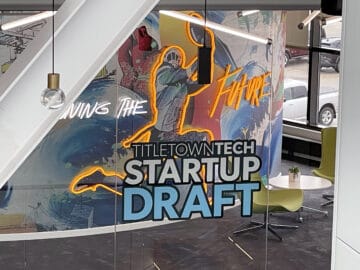 Seven companies set to participate in TTT’s Start-up Draft Combine
Seven companies set to participate in TTT’s Start-up Draft Combine Ardy & Ed’s Drive In serving up food and fun since 1948
Ardy & Ed’s Drive In serving up food and fun since 1948

